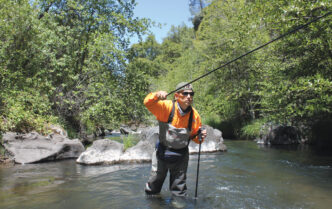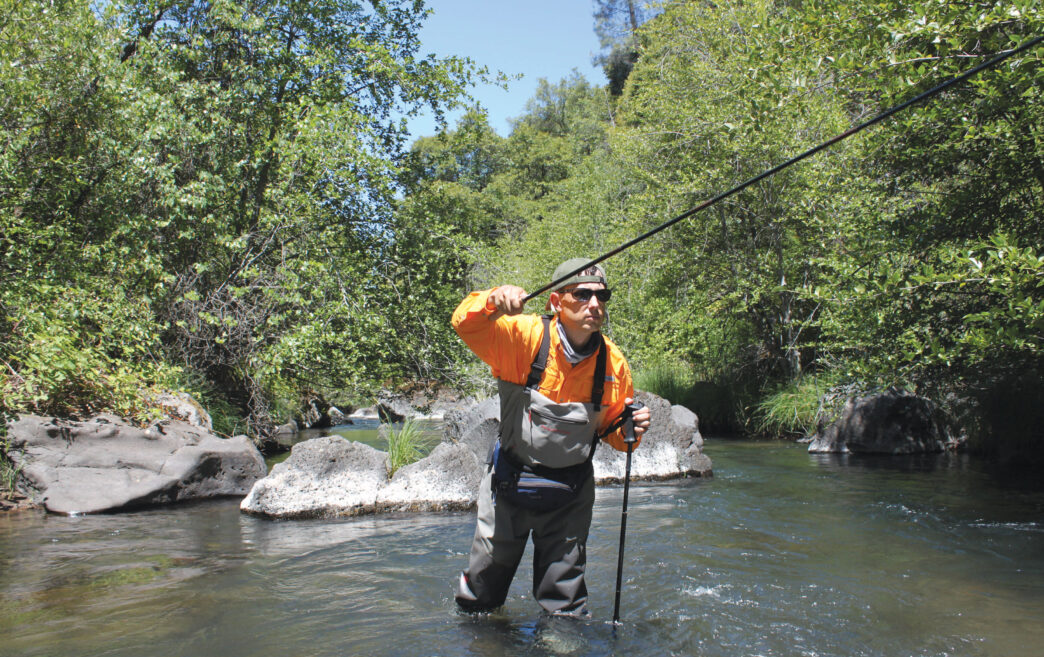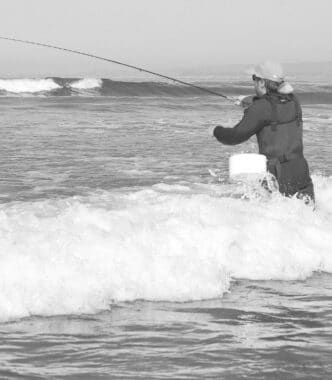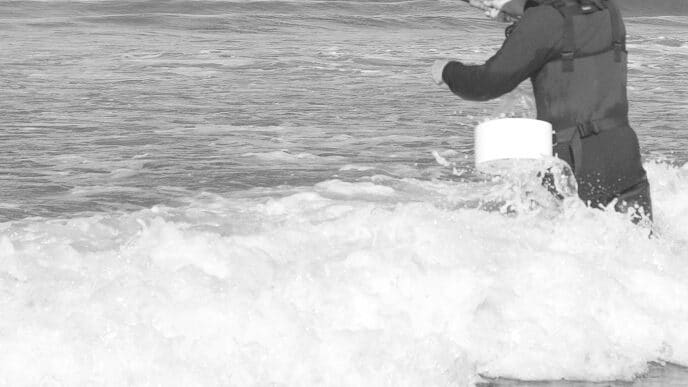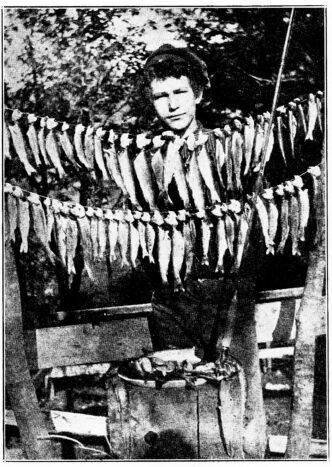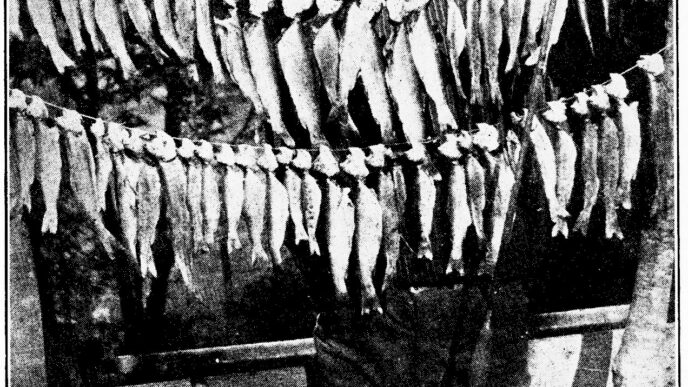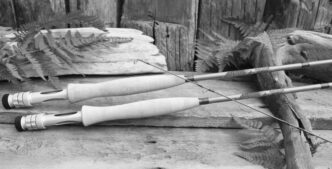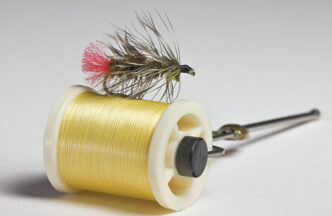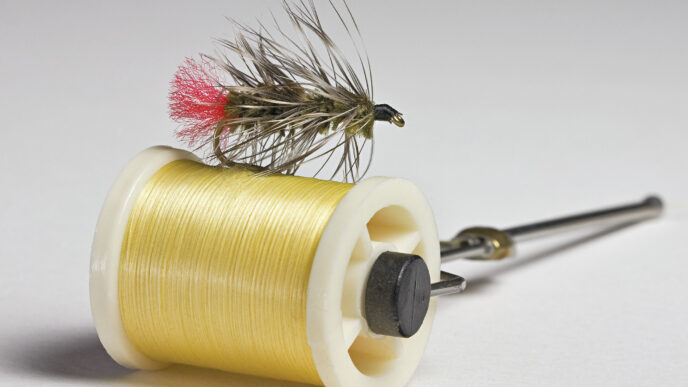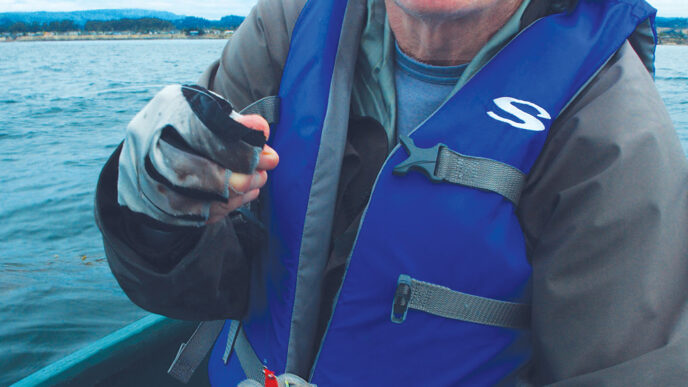My initial instinct when presented with the latest fly-fishing innovation is that “new” equals “bad.” Maybe it’s some sort of early-onset fuddy-duddyism, but I like fly fishing the way it is. Sometimes the positive attributes of a new product or technique are lost on me at first. I was not fond of Spey rods or Thingamabobbers when they were new, but look at me now. I guide lots of Spey trips, and I also spend significant amounts of time watching Thingamabobbers float down the river. Please note, however, that I never mix my Spey with my bobbers.
Last year, when I encountered some bizarrely long rods with no reels at the fly-fishing shows, my curiosity fought with my “new equals bad” instinct. The basic idea of fishing with a longer rod and no reel was actually fascinating. It didn’t seem too far removed from the short-line nymphing and dry-fly techniques we use on California’s high-gradient streams. I was taught to fish with a wading staff in one hand and my fly rod in the other, methodically working each current lane, seam, and any structure. When you can get close to the fish, there is no need to manage your line with your off-hand. You just pinch the line under the trigger finger of your rod hand and fish a fixed length. It seemed like a tenkara rod might enhance these short-line techniques by using the rod’s length to add a little extra range.
It turns out that tenkara was developed hundreds of years ago in Japan on rivers very similar to the mountain streams of California. Local commercial fishermen discovered that many trout could be caught by using a long bamboo rod, a line of fixed length attached to the tip, and an artificial fly. Modern tenkara gear aims to provide graphite rods that perform in a similar fashion. (For information on finding tenkara rods, lines, and related gear in the United States, enter “tenkara” into the Internet search engine of your choice.)
Commercially available tenkara rods are telescoping graphite rods that collapse to a length of 20 inches. Rods are available from a little under 11 feet to nearly 15 feet when fully extended. They have long cork handles and no reel seat, since reels are not used. The line is fixed to the tip of the rod and is of a fixed length.
Tenkara rods are meant to be fished fully extended. There are some models on the market that have two “locking lengths,” but most rods should be fully extended for casting. To protect the delicate tip of the rod, it’s a good idea to attach the line prior to extending the rod.
There are two types of lines: traditional Japanese furled lines and level lines. Both types of line are designed to be fished with a short (3-to-4-foot) section of tippet attached. The furled lines come in 10.5-foot and 13-foot lengths.
I found that with furled lines, I could cast about 20 feet. If you want to cast farther than 20 feet, you need to use a level line. The level lines were much easier for me to cast than the furled lines. Level lines come in 10-meter and 20-meter spools and are a type of fluorocarbon monofilament that you can cut to any length.
Cutting your fly line may sound a little extreme, but it’s just part of the tenkara program. Remember, a level line is not tapered, so you won’t be ruining the taper of the line. Since the line is fixed to the end of the rod, it is necessary to make several lines in order to fish at different distances. I found that a 10-foot level line works well on small streams and an 18-foot level line works well on larger rivers.
The basic configuration of these rods brings some obvious questions to mind. How do I land a fish? How far can it cast? What size fish can I catch? How do I fish different lengths of line? I answered these questions over the course of several tenkara scouting trips.
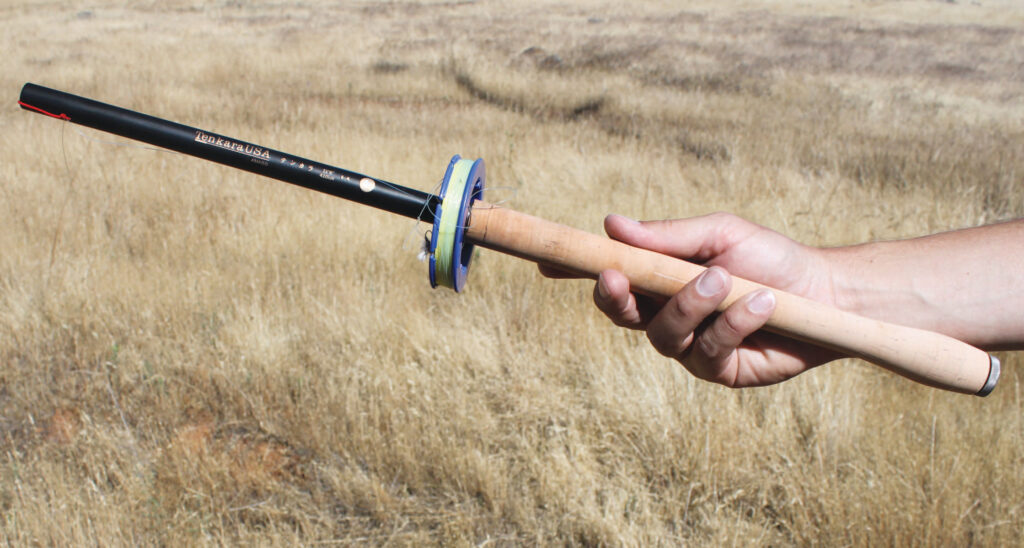
My first tenkara foray was on a small stream in Modoc County. I chose a stream that was fairly unencumbered by vegetation, figuring that a 12-foot rod would not mix well with lots of casting obstructions. I rigged up my tenkara rod with a furled line, 3 feet of 5X tippet, and a bushy dry fly. I was ready to do some fishing.
I walked up to where I could just reach a nice pool and made my first tenkara cast. I immediately got a strike and hooked my first tenkara trout. I raised the rod up as high as I could to hook the fish and was momentarily stumped as to how to bring it in. My line and leader were a few feet longer than my rod, so it was necessary to grab the line and hand-line the fish in the last three feet. I landed the small trout and released it.
Two thoughts came into my head at the same time: “This is easy!” and “Why tenkara?” I could already tell that tenkara is a fun, intuitive, and effective way to fish certain water types. My clients and I drove that point home throughout the afternoon as we hooked numerous fish on dry flies. Anglers who had never heard of tenkara rods hooked fish on their first casts with no instruction. But the nagging question remained: Why tenkara? If I already have all this regular fly-fishing gear, would I ever use tenkara in its place? It would take a few more trips to answer that question.
Tenkara on Large Rivers
I was itching to try a tenkara rod in a wide-open environment, and what better place than the lower Sacramento? On a very windy summer afternoon, my colleague Dax Messett joined me on a short float down the river. I was planning to test the high-stick nymphing capabilities of the tenkara rod, but the fish had other plans. We got to a broad riffle where dozens of trout were rising aggressively to Pale Morning Duns. I rigged up a 13.5-foot tenkara rod and decided to try the level line, instead of the traditional furled line. On a hunch, I made the line match the length of the rod and added 4 feet of 5X tippet.
Dax and I waded to within about 25 feet of some rising fish. That might sound implausible, but you can get really close to fish on the lower Sac, as long as they’re in the choppy riffles. I cast as close as I could to a rising fish. Casting a tenkara rod is easy. To throw a tight little loop, you make a very small casting arc. Since the rods are quite flexible, the pace of the casting stroke is relatively slow. With the level line, it’s fairly easy to place the fly accurately, even in a moderate wind. I got a couple of grabs, but my line was clearly too short to reach most of the fish. I constructed a new level line about 18 feet long, added some 5X tippet, and reattached my PMD dry fly. Much better!
With the longer line, I could still cast easily and target fish accurately. Fish were rising all over the place, and pretty soon Dax and I were taking turns catching fish. It is really fun hooking and playing a fish on a tenkara rod. A 10-inch fish puts a pretty big bend in one of these rods.
Modern tenkara rods are meant to be used with relatively light tippet, 5X and lighter. These light tippets are necessary to avoid breaking the delicate rod tips. But when using a longer line, there is a moment when you make the transition from lifting the rod to grabbing the line and hand-lining the fish. Once you start handlining, it is easy to break off a larger fish on the light tippet.
How big a fish can you land on one of these rods? My largest to date is 12 inches, and I think you could land trout up to 18 inches with some of the longer rods. The key is to have a relatively short line so you don’t have to hand-line the fish. A big fish on a long line would need to be hand-lined and would probably break the tippet. Nets can be used when tenkara fishing, but a net gives only one to two extra feet of reach, which will probably not be enough to avoid hand-lining the fish.
How far can you cast with a tenkara rod? With an 18-foot level line, I could place a fly accurately over 25 feet away. My guess is that you could make a level line double that length and still cast it fairly well. The difficulty is in landing a fish. The longer the line, the more hand-lining is required. Extensive hand-lining will make you miss your fly reel in a hurry, but it will get the job done if you absolutely need to make a long cast.
Tenkara on Small Streams
My nymphing plans foiled on the lower Sac, I decided to try again on the North Fork of Battle Creek. The private section on which I fish and guide is somewhat overgrown, has challenging wading, and is loaded with small-to-medium rainbow trout. While these fish love to eat dry flies in the afternoon and evening, they are total pushovers for a nymph any time of day.
My high-sticking instincts guided me to set up the rod with a line and leader equal to the length of the rod. I again used the level line and a 3-foot leader of 5X. I made a few casts into an enticing run and was rapidly rewarded with a strike. I set the hook, missed the grab, and launched my fly high into a streamside willow. Lesson learned. These rods are very sensitive to strikes, but you can’t set the hook hard, the way we do with normal fly rods.
In tight quarters, the best way to set the hook is to lift or pull away from the fish gradually. If the fish stays attached, gradually pull harder. Avoid any sudden hook sets. Sudden, powerful hook sets will result in many lost flies.
After landing well over 10 fish out of a single run, the verdict was in: Tenkara rods are high-stick nymphing machines! The rods are incredibly sensitive to strikes and to the bounces of a fly along the bottom of the river. I was able to detect strikes easily by feel or by watching the level line where it entered the water. It was surprisingly easy to make a controlled roll cast right over the tip of the rod and place the fly accurately upstream. In many places on Battle Creek, there isn’t a lot of room to cast. I found that by making creative roll casts I could effectively fish some fairly tight spots.
I fished as many as three BB-size split shots without incident. I don’t think these rods are meant to be fished with weight on the line, but I was very deliberate with my casts and took care to avoid any motion that would send the BBs on a collision course with the rod.
Once you try nymphing with these rods, it becomes readily apparent that the rods have great feel and that you can impart a lot of action to your fly. These attributes make downstream fishing very appealing. On small streams, we typically fish our way upstream with normal fly gear. I found that I could catch a lot of fish with my tenkara rod by working downstream. From above, you can lower a nymph into a hole, twitch it back up, swing it across the currents, and more. I hooked some of my largest Battle Creek rainbows by employing these downstream techniques.
I tried some dry-fly fishing and some dry-and-dropper fishing, too. The hooksetting issue made dry-and-dropper fishing difficult. When fishing a dry with a dropper nymph, many of the nymph grabs are very fast and demand a quick reaction to hook the fish. If you have room to spare, it will work fine. If you’re on a brushy stream, I do not recommend the dry-and-dropper technique with tenkara rods. You will decorate the streamside vegetation with flies and turn the air blue with bad words.
Limits of Tenkara
There are many things normal fly rods and reels can do that tenkara cannot. Without the ability to play out slack line, long downstream drifts are out of the question. Long casts and long retrieves are clearly not an option, either. Indicator fishing in its various forms, while not strictly impossible, is certainly not what these rods are intended to do. To be succinct, tenkara rods are designed for moving water where you can get relatively close to your quarry.
The biggest drawback to tenkara fishing comes when landing fish. Every time I hooked a fish, I wished I could reel or strip the line in. However, a reel means extra weight and necessitates line guides on the rod. Line guides mean no collapsible rods. The appeal of tenkara is the simplicity of the technique and the ultralight, sensitive nature of the rod. You can’t have it both ways.
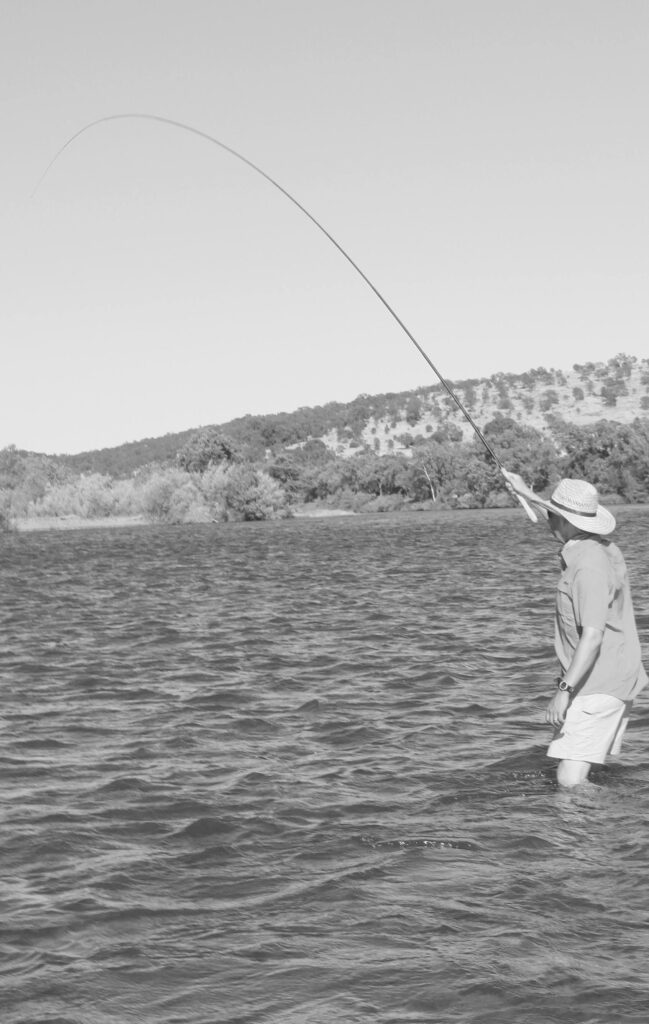
Advice for Newbies
Based on my tenkara test drives, I offer the following advice to tenkara newbies. For starters, ditch the traditional furled lines and go straight to the level lines. The level lines come in a high-visibility version on a 20-meter spool and a medium-visibility version on a 10-meter spool. I recommend the high-vis version, especially if you plan to do any short-line nymphing with these rods. The high-vis level line is easy to see and makes a good visual indicator for detecting strikes.
Add a permanent butt section to the lilian, the strong braid material that emerges from the tip of the rod. While the system devised by the manufacturer for attaching the lines is clever, it is not as convenient as a loop-to-loop connection. Attach 20-pound-test mono to the lilian with a Nail Knot. Then put a Perfection Loop in the other end of the mono. Make this permanent butt section as short as possible. Now you can loop your level line to the tip of the rod.
The “Tenkara Line Holder” is an essential accessory. This is a foam spool that easily stores two lines. This clever piece of gear would no doubt work great for regular leaders, as well.
These rods are not for very small streams. Plan your first tenkara trip to a stream that has some casting room. Be psychologically prepared for some awkwardness for the first hour or so. Fishing a 12-foot rod can be challenging to your spatial awareness.
Also, take care when removing your fly from a tree limb. These rods are very delicate at the tip end. Collapse your rod when you snag in a tree and pull the line.
So: Why Tenkara?
Tenkara rods are definitely effective when fishing moving water. Able to handle dry flies and nymphs in numerous applications, these are versatile rods for trout angling and can be plied on a wide range of water types, from the pocket water of the Pit and McCloud Rivers to the riffles on the lower Sacramento. But are there any scenarios in which a tenkara rod would be preferable to a normal fly rod and reel? Absolutely.
My initial hunch about high sticking nymphs with tenkara rods was correct. The added length makes it possible to extend your range a little bit. This added range comes in handy on rivers such as the Pit, where many inviting pockets are just out of reach for even a 10-foot fly rod. With my 12-foot or 13.5-foot tenkara rod, I can get great drifts in water that would be hard to fish with my normal rod and reel. You could do the same thing with a short Spey rod or a long switch rod with a reel, but these rods seem incredibly heavy and stiff after using a tenkara rod.
Tenkara rods also shine on brushy streams such as Battle Creek. The ability simply to collapse the rod when you need to walk through brushy areas is a huge advantage. Plus, when you decide to call it a day, just collapse the rod, put the cap on, and throw it in your backpack or the back of your vest. The collapsibility saves a lot of headaches trying to weave a 9-foot rod through the brambles. I foresee many occasions on small streams when I will leave my fly rod and reel at home and take my tenkara rod instead.
The sheer packability of tenkara rods makes them a no-brainer for many applications. When space is at a premium, a tenkara rod will fit. On a multiday backpacking trip, opting for tenkara over the normal rod and reel will save you weight and space in your pack. All you need is the rod, which collapses to 20 inches, some level line, tippet material, and flies. To be fully prepared, add nippers, hemostat, floatant, and some split shot. This barebones selection of gear packs down really well and could be the perfect thing to stow in the car for impromptu fishing opportunities, not to mention the family camping trip, when you might get an hour of fishing in here or there.



